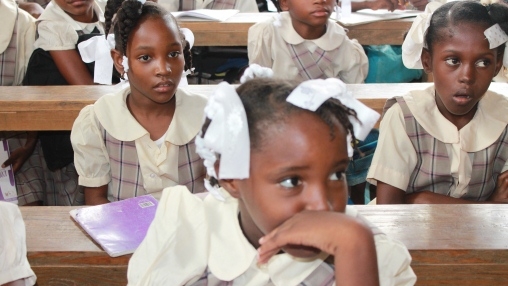Challenge
The Haitian Government and the Bank wanted to achieve “quick wins” to provide hope to Haitians who were suffering from a near total lack of public social services. Nearly one-half of Haitian children did not have access to primary education. An estimated 8,000-10,000 primary teachers were needed to absorb out-of-school students. To make the challenge even more daunting, a devastating earthquake occurred on January 10, 2010 that left more than 200,000 people dead, including an unknown number of students and teachers. There was widespread destruction of infrastructure, schools and Government buildings, including the Ministry of Education (MENFP) and IFMs.
Approach
The key feature of the Project was the accelerated and practical approach to teacher training with one year of pedagogical and two years of practical training. This new approach contrasted with the traditional training model of three years of institutional training in Ecoles Normales . The design of the program ensured better quality student-teachers because of stricter selection criteria (passing an examination, having completed high school and remedial training). The higher quality of the student teacher made it possible to reduce the pedagogical component of teacher preparation from three years to one year.
Results
There were a number of positive results that are expected to lead to improved educational outcomes:
- Number of new teachers certified - 1,390 actual for cohort 1;
- Number of student teachers completing the first year of practice teaching - 1,526 actual for cohort 2);
- 100 percente of graduates certified ;
- Auditors found satisfactory implementation of MENFP-IFM contracts, which represents improved management capacity in training institutions (IFMs)
Bank Contribution
The Bank financed the Project with US$5.8 million in IDA Grant resources.
Partners
The MENFP implemented the Project through technical departments, primarily the Department of Training and Professional Development, and received administrative and fiduciary support from the Adaptable Program Grant-Education For All (APG-1) Project Technical Unit (PTU), which worked with the Department of Administrative Affairs of the MENFP.
Moving Forward
The teacher training program is becoming more established within the IFMs, which will have fully implemented, with Bank financing, a second cohort of new teachers by June 2013, who will be deployed in classrooms in October 2013. In addition, the teacher training curriculum has been improved which will enhance the quality of the training and, therefore, the quality of education received by primary school students for a number of years. At the same time, implementation of teacher training will continue to depend on donor assistance. A second phase of the operation is allocating US$8 million to the continuation of the program, including cohort 3 (begun in September 2012) and cohort 4 (to begin in September 2013).
Beneficiaries
It is projected that the teachers trained through the project will provide an additional 2.3 million student years of classroom education during the course of a 20-year career, which is a conservative assumption. Teacher trainees in Nippes and Sud Est provinces reported that the project gave them a unique opportunity to become teachers. Officials at the MENFP and at the IFMs reinforced these views underscoring that the Formation Initiale Accelere was the first of its kind in the country.

